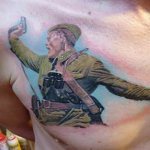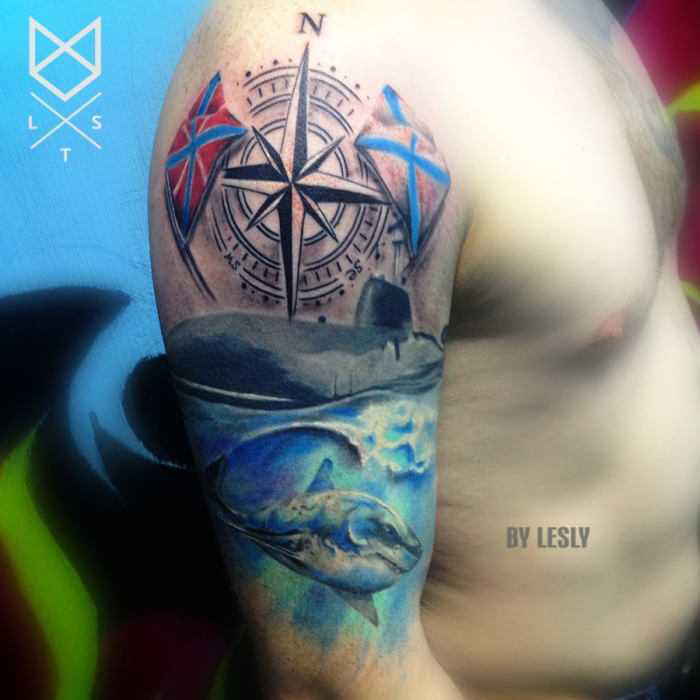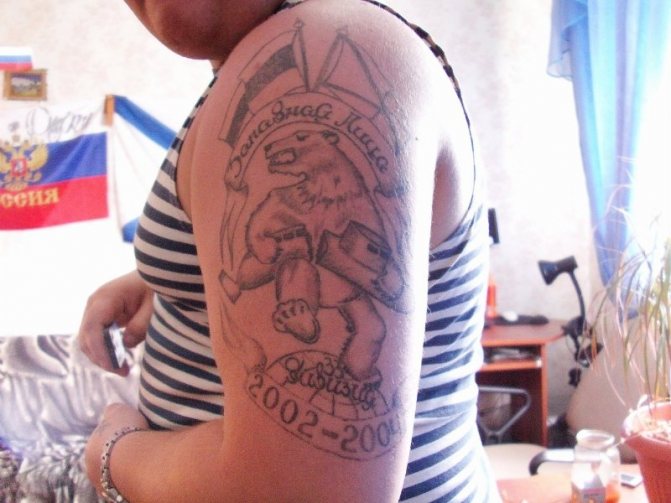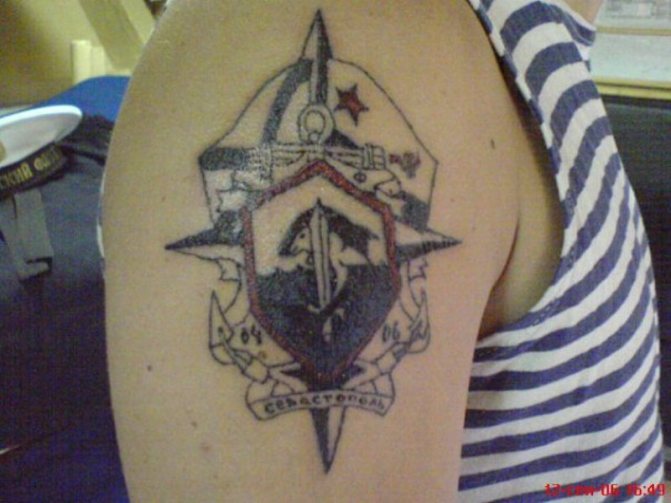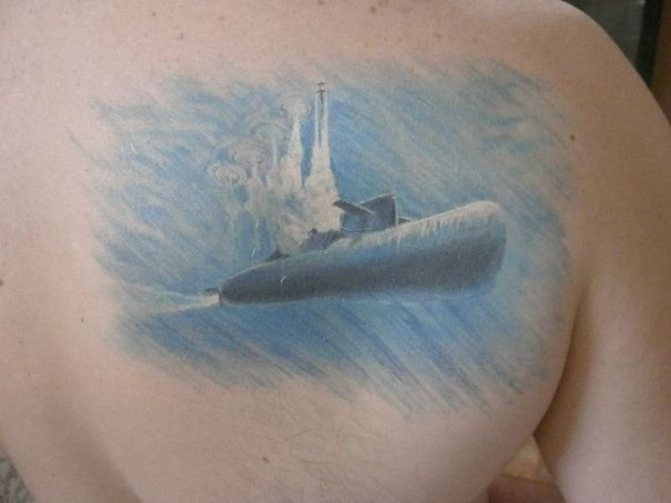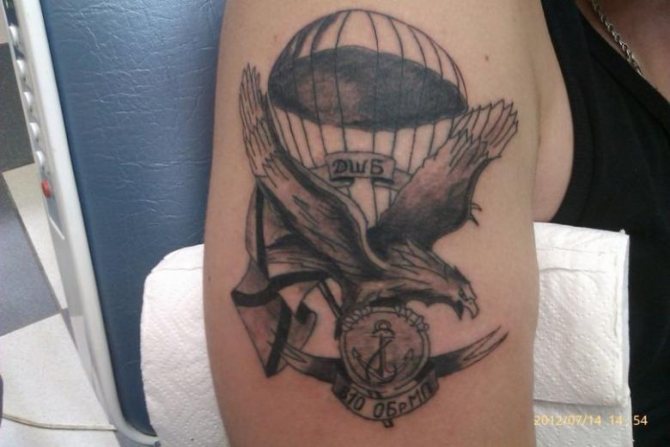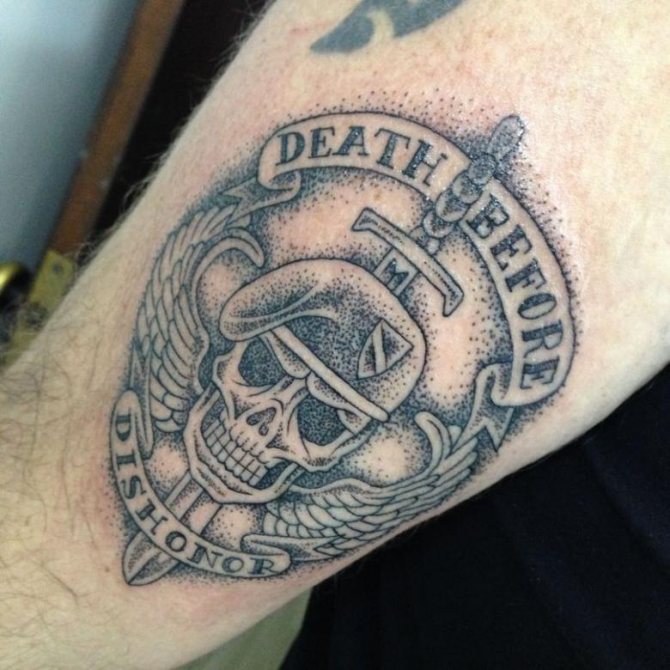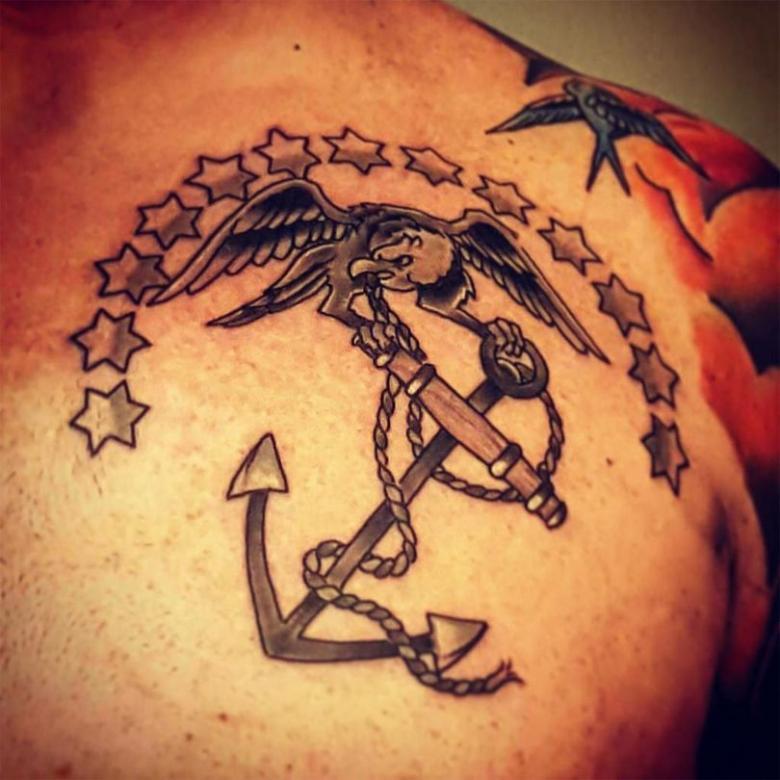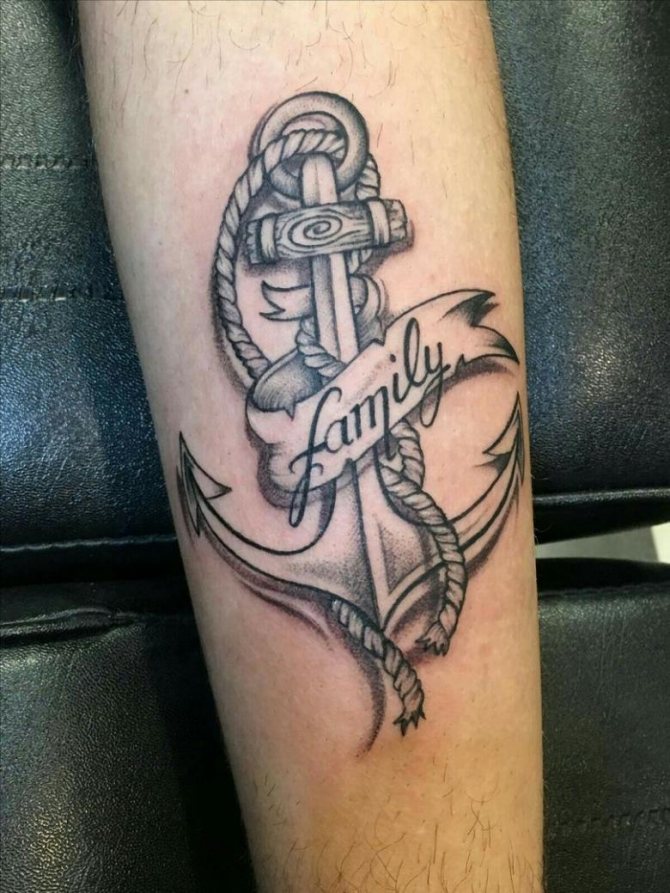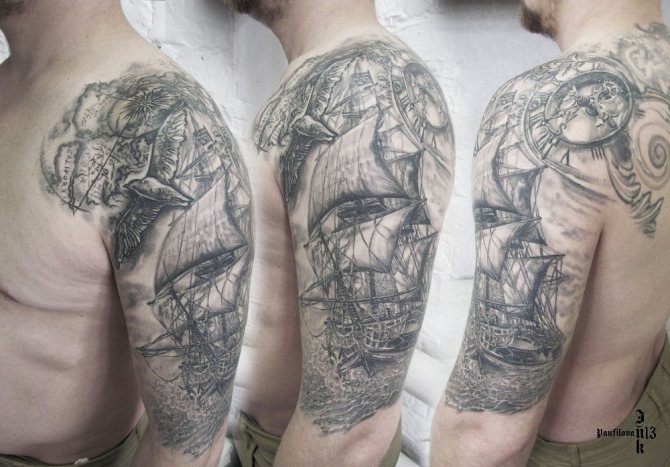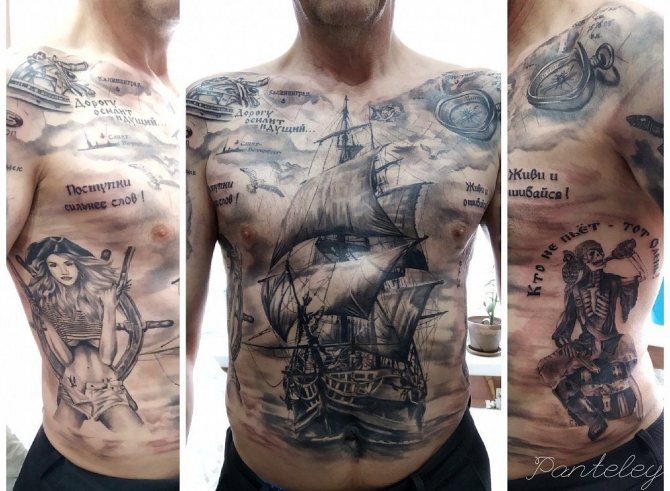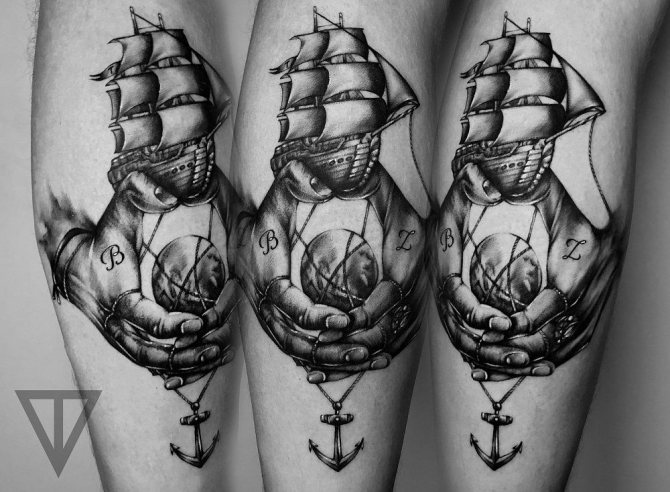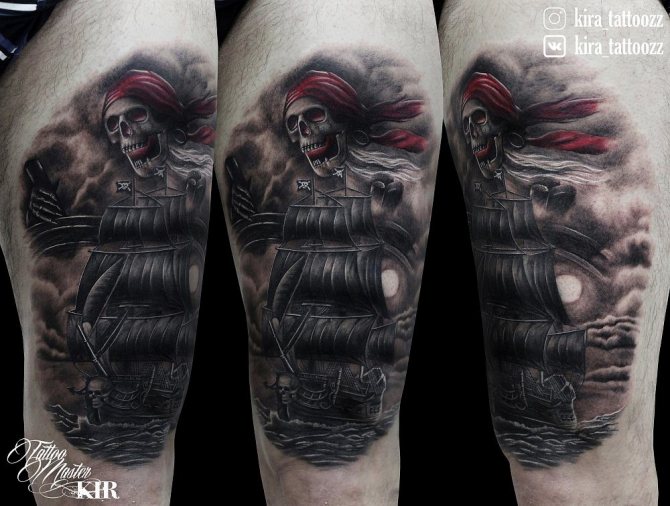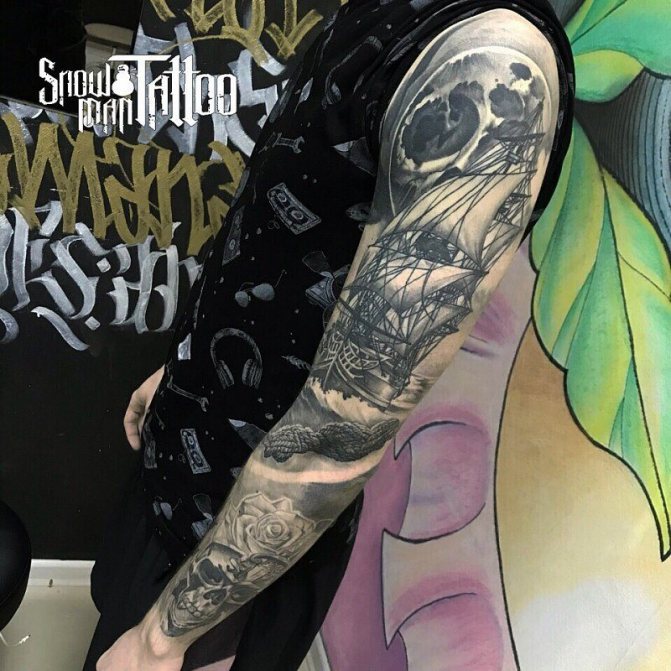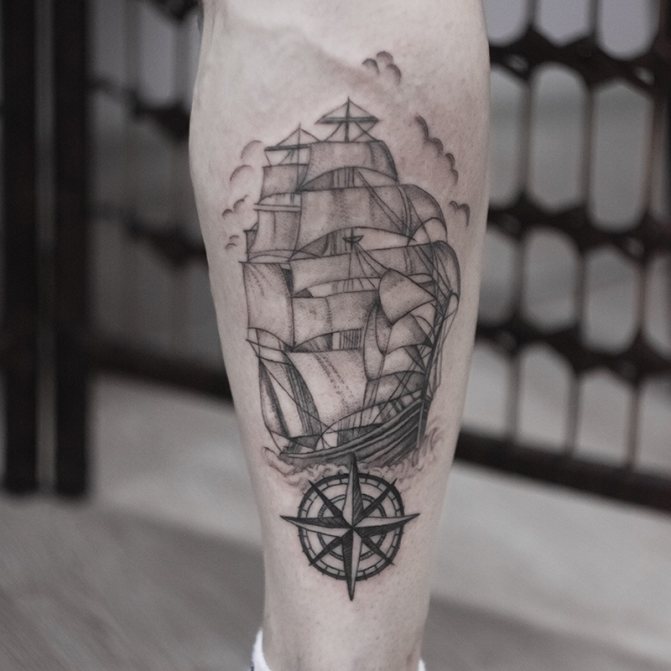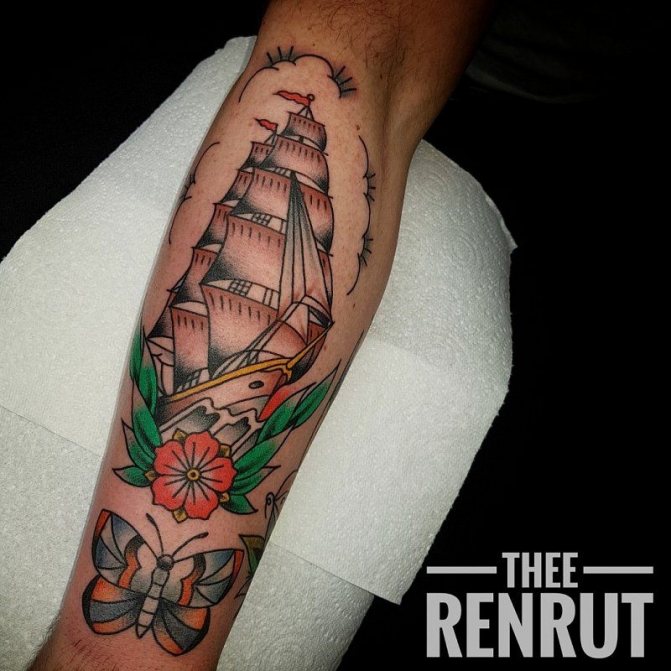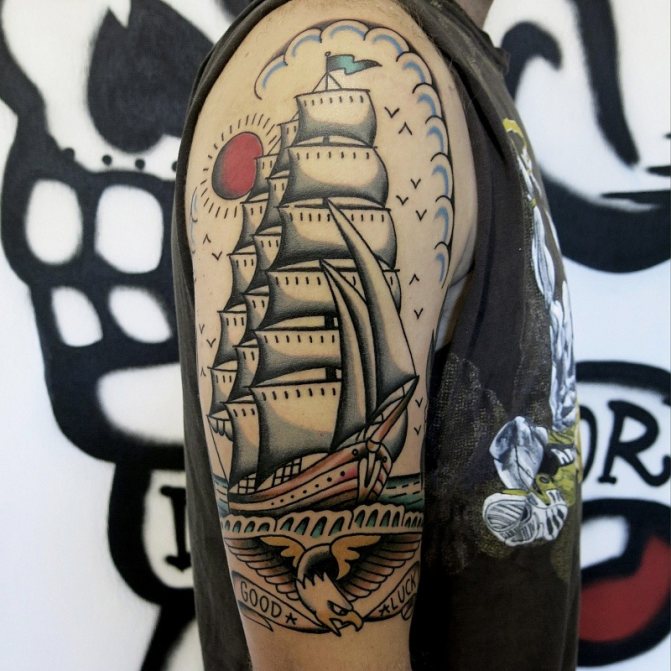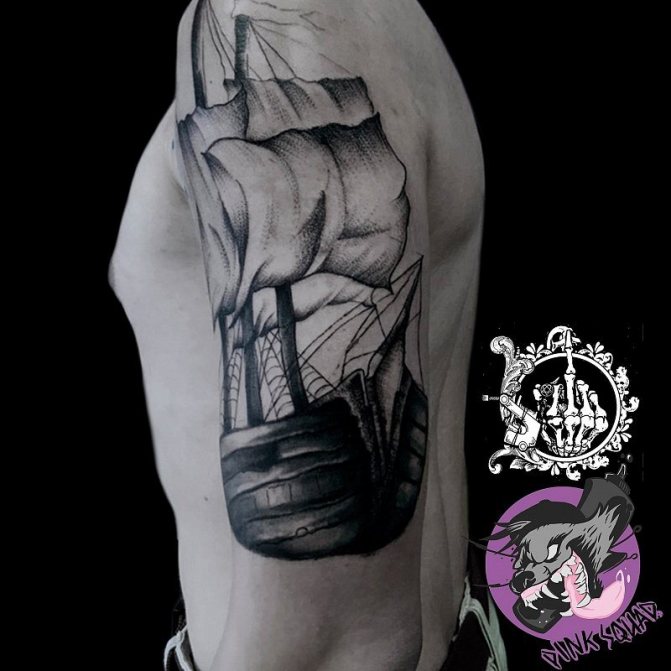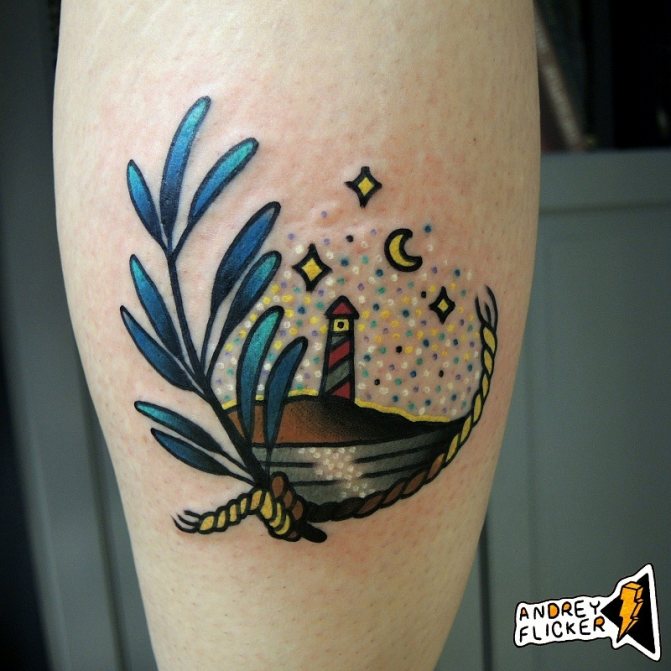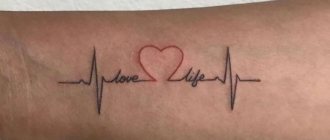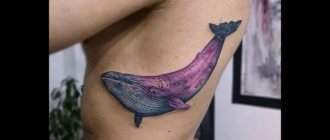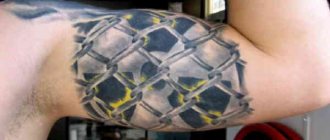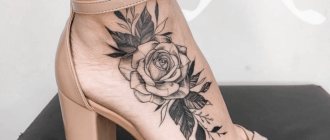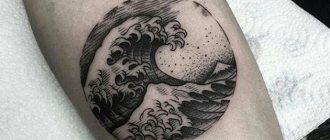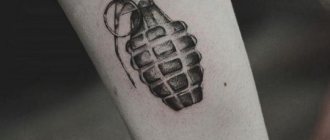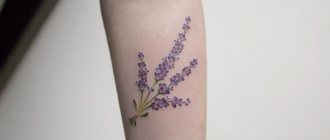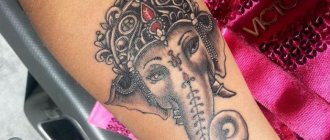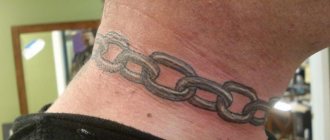The sea abyss is dangerous and unpredictable. Any sailor will confirm that. The intrigue of the water surface is best reflected in the tattoos of those who at least once went under the sail of the navy. It is sailors are considered the popularizers of the art of body art. Marines tattoos are always symbolic. The deeper meaning of the images on the bodies is the additional protection from dangers. At the same time, the excessive aesthetics of the drawing are not important for men with a maritime destiny.
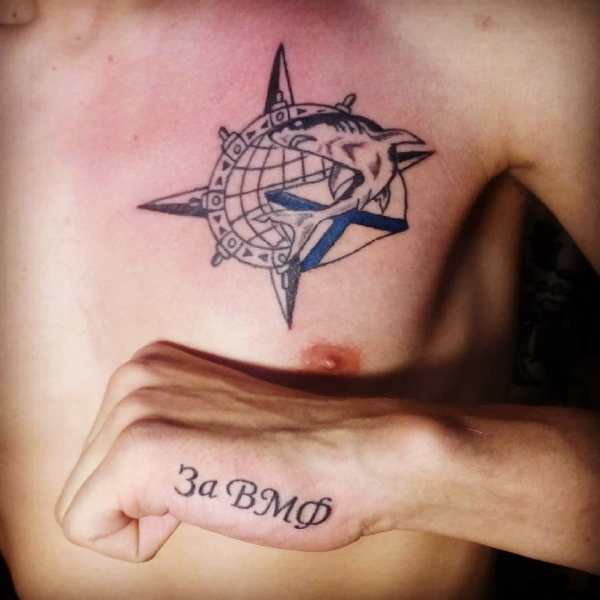
How did the military theme enter the history of tattooing?
According to historical sources, body art has long been used by warriors around the globe. Some medieval authors claim: the Slavs had tattoos before the baptism of Russia. There is similar evidence about the Yenisei Kyrgyz: travelers from the Celestial Empire described in detail the appearance of the brave Siberians. With the Indians, military tattoos and their meaning were clearly defined. The tattoo signified initiation, tribal affiliation and participation in battles. It also carried a sacred meaning, protecting against injury, death and defeat in any battle with the enemy. Today similar tattoos are present only at the representatives of the tribes closed from a civilization, but it is possible to look impressive on the expression of military tattoos on the photos made in XIX century by the ethnographers.
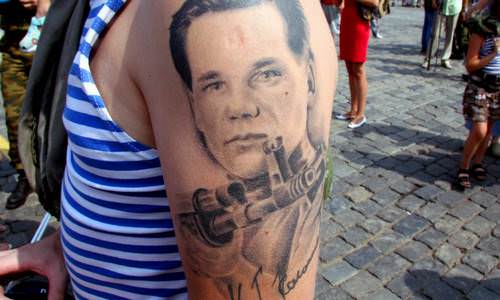

Military tattoos - photo
During the Late Middle Ages many geographical discoveries were made, the borders of the world were expanded. European sailors who swore allegiance to a state and traveled the oceans were interested in such a form of protection. Virtually everyone who came into contact with Polynesian, Indian tribes, Papuans, was imbued with mythology and had military tattoos for men. Researchers believe that the measure was forced and allowed the Europeans to establish themselves in a positive way, to fit into the local community.
By and large, military and army tattoos came to Europe, and from there to Russia, thanks to sailors. Harsh conditions and dependence on the elements led them to believe in fate and seek protection from mythological creatures. Over time, each group of troops came up with symbols to distinguish those in their group. In the second half of the 20th century, tattoos took on a special meaning: in the era of large-scale wars and the use of powerful weapons destroying everything around, additional identification signs were needed.
Did you know? During the Soviet campaign in Afghanistan, soldiers, following the example of the Americans, began to have their blood type tattooed. Military tattoo designs related to the Airborne Forces became popular. Officers who have served here refer to themselves as an elite group. Everyone seeks to leave the memory of years of service on the body.
Widespread in the former Soviet Union army tattoos by type of troops are classified quite clearly. Among those who have served and especially participants in real military operations, their bearers inspire respect. Those who did not serve in the army should not apply them. If exposed, some of them can even be aggressive, punishing for disrespecting those who risked their lives in the war.
The evolution of tattoos in the U.S. Navy
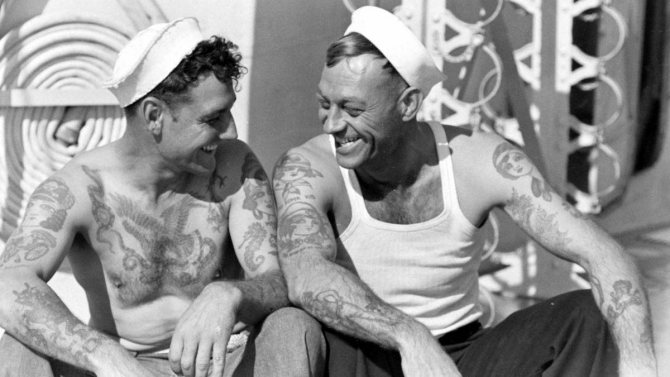

Tattoos are much more than just expressive drawings on the body.
For some groups of people, such a drawing carries a special meaning that shapes the perception of its owner.
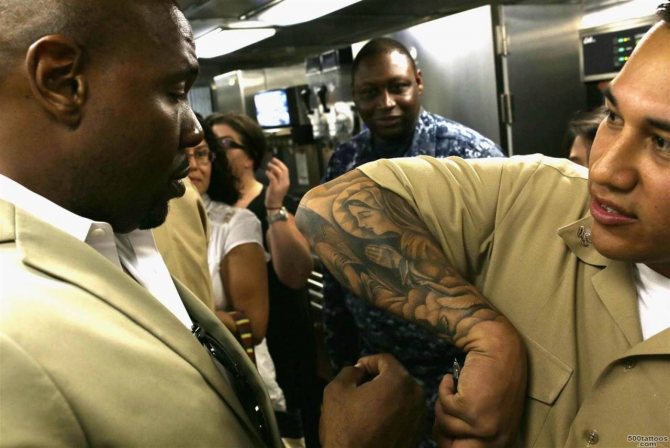

If a person unjustly wears such signs, it can be regarded as an insult and imposture.
The consequences in the Russian zone can be very unfortunate for fans of such art, if they do not understand the inner meaning of the depicted symbols, endowed with already archetypal meaning.
But we will consider this problem on the example of the U.S. Navy through the prism of assessing the moral, political and psychological state of its personnel.
The tradition of tattooing in the United States Army came from the Navy.
In fact, modern tattooing in the West can be traced back to the fifteenth century, when European pilgrims marked themselves with reminders of the places they had visited, as well as the names of their hometowns and spouses, to help identify their bodies should they die during their travels.
Although tattooing was already present in much of Europe, in the 1700s the visibility of exotic voyages made by men like Captain James Cook helped solidify the connection between tattoos and sailors in popular media.
Captain James Cook's voyages to the Pacific Ocean in the second half of the 18th century are believed to have discovered Polynesian body art for sailors in the Royal Navy.
The English word "tattoo" is actually a descendant of the Tahitian word "tatau," which Cook recorded after stopping on an island during a voyage across the South Pacific.
The body art was particularly well suited to the transient and dangerous nature of life at sea.
"These sailors were traveling the world and wanted to bring back souvenirs from the places they visited." "You don't have much room to carry fancy souvenirs aboard ship, so you end up with tattoos as travel marks."
By the end of the eighteenth century, naval reports show that about a third of British and a fifth of American sailors had at least one tattoo, while other reports show that sailors in the French, German and Scandinavian navies also liked to get tattoos.
The popularity of tattoos quickly spread from the British to American sailors. Avoiding the boredom of long hours at sea, sailors acted as amateur tattoo artists.
During the American Civil War
Tattoos commemorating the historic clash of the battleships USS Monitor and CSS Virginia appeared in both fleets along with more general motifs such as military insignia and names of lovers. When tattooed sailors returned home at the end of the war, the work of Civil War tattooists spread across the country.
During World War I.
- in keeping with the notion of the higher purpose of the progressive era-which also abolished alcohol rations in the Navy-navy recruits were strongly encouraged to cover up any risky "body art," as the perceived "moral" flaws of the images applied could disqualify them from serving.
Sailors began to seek alternative patriotic tattoos reflecting their enthusiasm for America's participation in the war effort.
For many years, the U.S. Navy has had stricter rules and standards regarding tattoos than other branches of the armed forces.
Extensive expansion of the Navy during World War II
laid the groundwork for greater acceptance of tattoos in society.
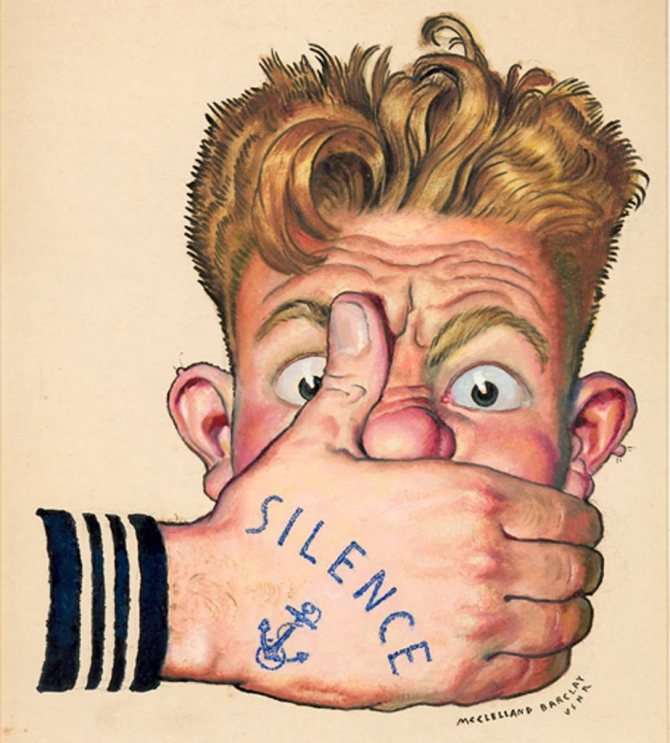

Even official U.S. Navy posters featured ubiquitous navy tattoos, like this image from the '40s campaign, Loose Lips Sink Ships.
This, and the increasingly multicultural composition of recruits entering the Navy in the 21st century, has led to the liberalization of tattoo regulations, the least stringent of any branch of the U.S. military.
In 2021.
the Navy changed some body-care standards, including leaving far fewer rules for tattoos.
The policy was also updated in 2021
to allow one tattoo on the neck (if it is less than one inch in diameter).
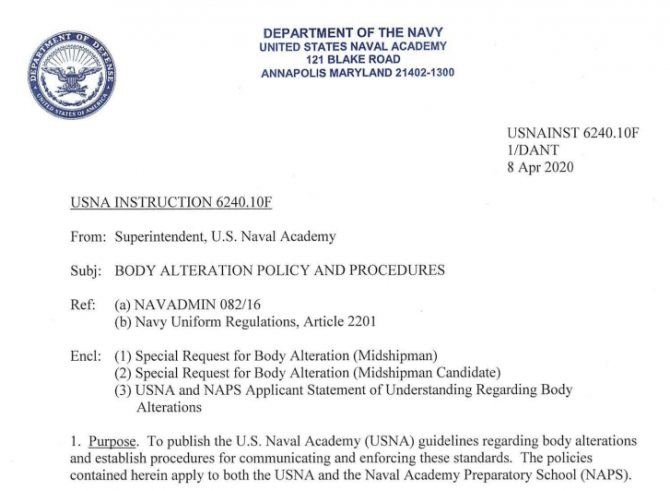

Navy Tattoo Policy and Regulations
The updated 2021 Navy tattoo policy is now one of the most lenient in all branches of the armed forces (previous policies banned any tattoo on the neck and limited the amount of ink that could be shown on the forearms or legs).
New Policy 2021
- is a small but significant change from the sweeping reform of body art in the various branches of the military that began in 2021.
The new rules allow unlimited tattoos on the legs, arms, neck and even on the arms and behind the ears.
The only restricted areas on the body are the head, face and scalp. Tattoos on the torso are also allowed, but they must not be visible under white fabrics.
Therefore, the number of tattoos on the arms or legs is no longer regulated for sailors.
Sailors were thrilled to finally have "ink sleeves" covering their forearms to their wrists, even their hands. And members of the Navy were thrilled that they could appeal more broadly to a generation that favored body art.
"It came down to being honest with ourselves about the realities of the society we live in today," said Navy Chief Petty Officer Mike Stevens, who was the driving force behind the change. "And if we are a reflection of that society, we need to embrace that and develop policies that reflect those realities."
Some changes in Navy policy have so clearly resonated with sailors, he said, as the Navy's decision to relax its policy on tattoos.
«I will tell you that tattoos are an art form, and art is a form of communication
, and just as we speak verbally, tattoos also speak," he said.
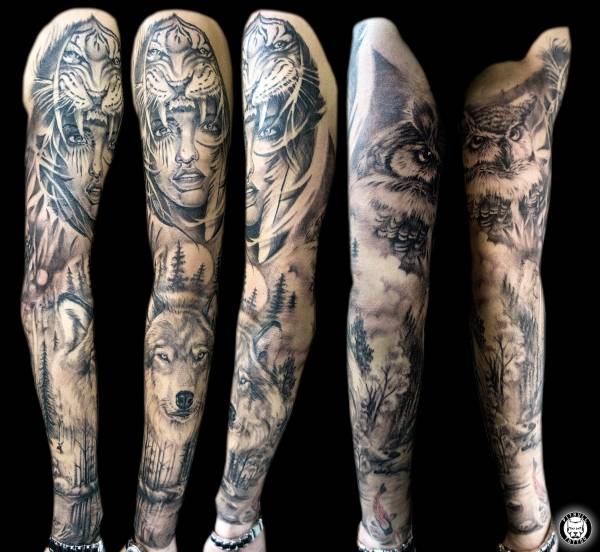

A few examples of authorized arm tattoos
Arm tattoos, including ring tattoos, are also allowed under new U.S. Navy regulations.
The basics of the new policy:
- You can get one tattoo on your neck as long as it is less than 1 inch in diameter. - You may get tattoos on your arms from top to bottom. - Hand tattoos, including rings, are also allowed. - No tattoos are allowed on the head, face, ears or scalp. - Offensive, racist, extremist and sexist tattoos are prohibited.
The U.S. Navy categorically does not tolerate when it comes to body images that are deemed "offensive, racist, sexist, extremist or defamatory of America.
The new Navy tattoo policy gives officers the same privileges as enlisted sailors (thus, Navy officers are allowed to have tattoos below the elbow or knee, places on the body that were previously restricted before the updated policy).
The meaning of classic sailor tattoos
The U.S. Navy has a long tradition of tattoos.
Here's the meaning of some of the classics.
Sailboats.


A tattoo with a sailing ship under all sails from the sailing era means that the sailor has rounded Cape Horn, the southern tip of South America.
Now it's more of a historical tradition with no specific geographical reference.
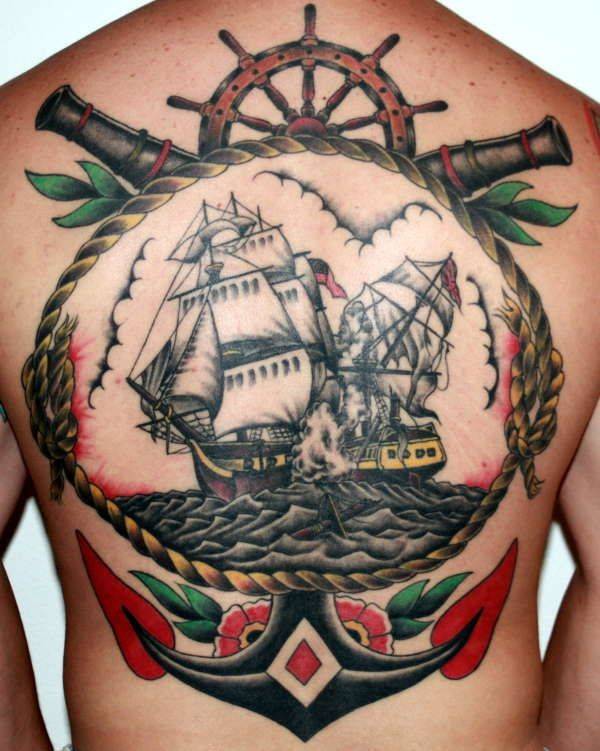

Sailor's Star.
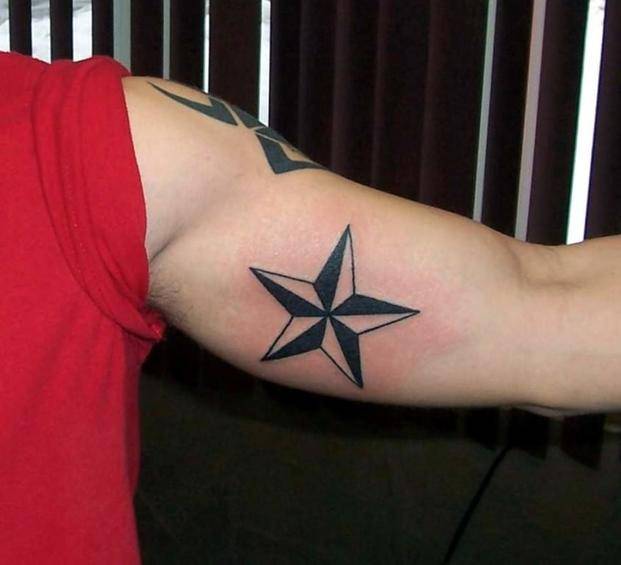

The star is the symbol of the sailor who can always find his way home. The starfish is a five-pointed star in dark and light shades, sometimes modified to resemble a compass rose of the winds.
The shell turtle.
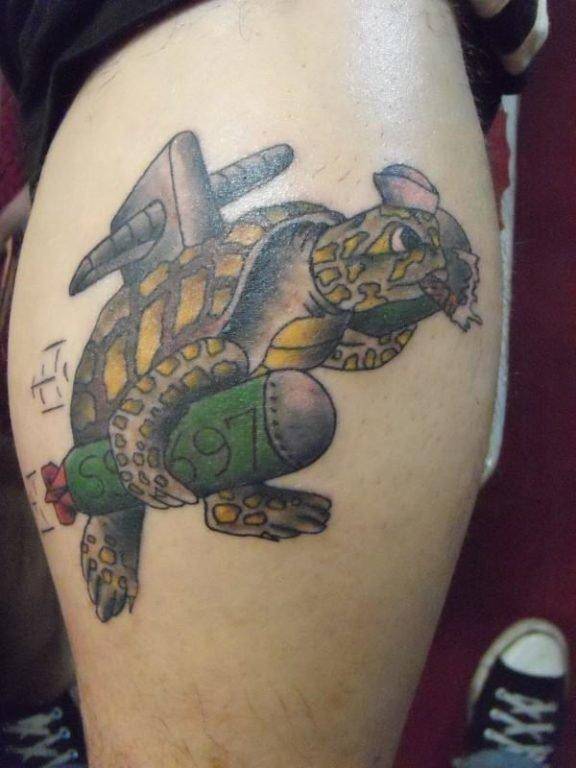

Sailors may wear a shell turtle after crossing the equator.
Crossed cannons.
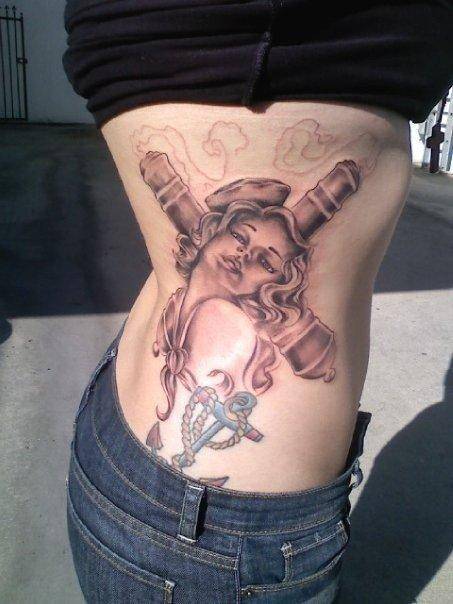

Crossed cannons mean that the veteran had military service as a sailor.
Swallows.
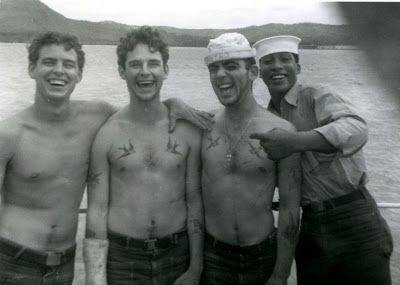

Sailors earn a new swallow tattoo for every 5,000 nautical miles, which is about 5,754 regular miles, roughly the distance between New York City and Tel Aviv (the circumference of the Earth is 21,639 nautical miles, about 4.16 swallows total).
Anchor.


A single anchor means that the sailor crossed the Atlantic or was a member of the merchant fleet, a fleet of civilian ships carrying military cargo. In wartime, this fleet is mobilized to carry military equipment, including troops and supplies.
Like crossing the equator, crossing the Atlantic is a mark of experience.
During World War II, the Merchant Marine entered the European War long before the United States itself and suffered heavy losses.
Wrist rope.
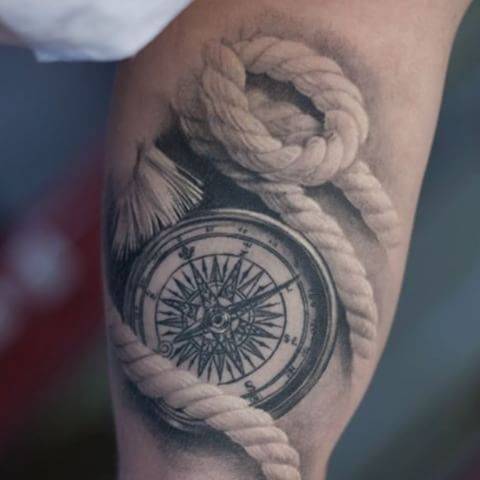

The knot of rope on a sailor's wrist identifies him as a sailor, the person who maintains the hull, deck, superstructure, mooring and loading and unloading. This is practically the entire bosun crew.
Hawaiian Girl.
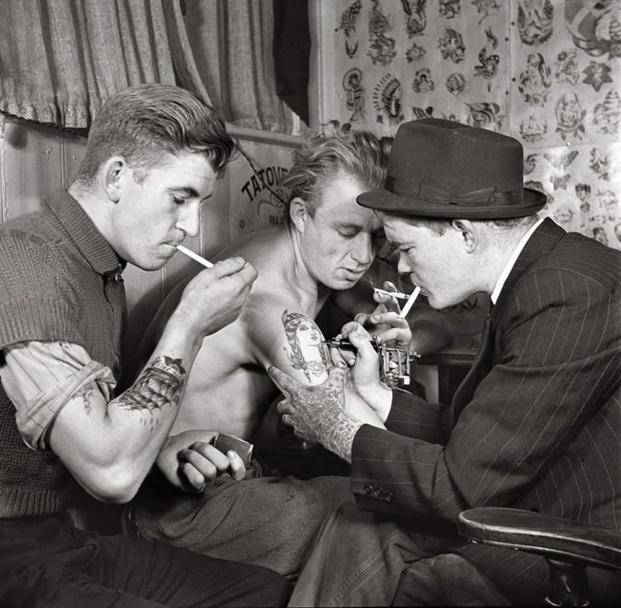

Hula Girls." (doll, Hawaiian Barbie) mean that the sailor was in Hawaii.
Crossed anchors.
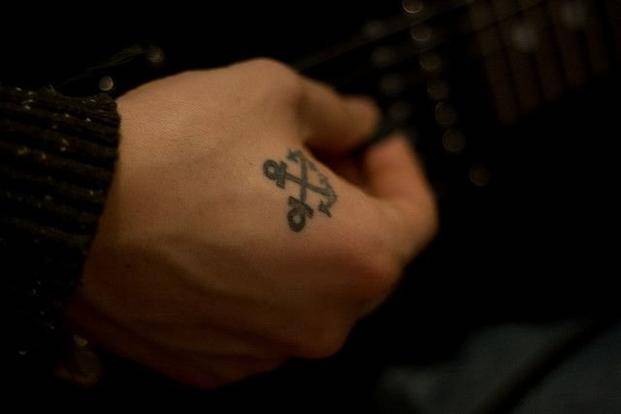

Sailors who wear crossed anchors on their straps between their thumb and forefinger identify themselves as fellow bosuns, guys who maintain the deck and take care of small boat operations and emergency services.
Hold fast and tight.
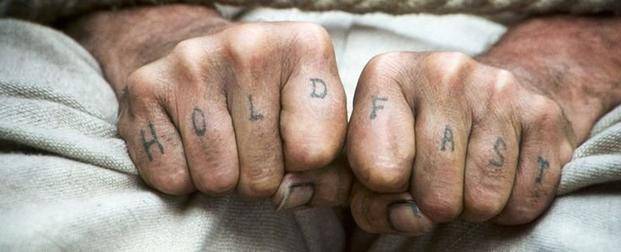

These words are a spell on the four forward-facing fingers on each hand. Sailors hope it will bring them good luck when grabbing the rigging. Holding on tightly means that the sailor is not going to let go of the rope, no matter what. Sailors were a superstitious bunch, and life on a sailboat was hard (to put it mildly). Anything that gave them an advantage in saving their own lives was worth it.
A pig and a rooster.
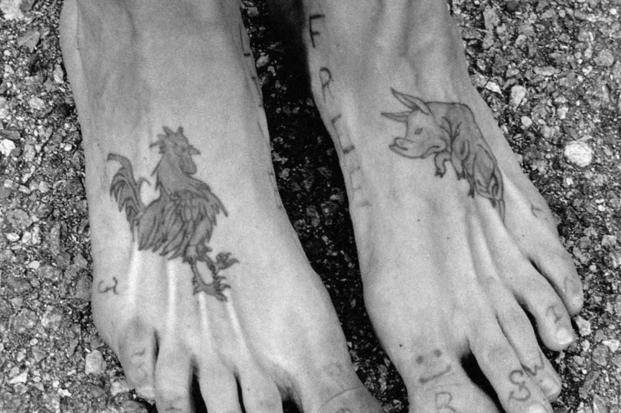

Tattoos on the feet of pigs and roosters were worn by sailors during World War II in the hope that it would keep a sailor from drowning. At the time, the navy shipped these animals in crates. When ships sank, the crates floated and the animals inside were sometimes the only survivors.
Compass on a wind rose.
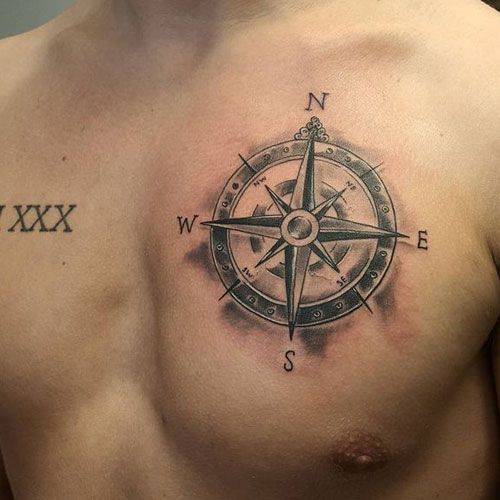

Another good luck charm, allowing the sailor to find his way home.
Crosses.
These are believed to be applied on the soles of the feet to scare away sharks.
A dagger through the rose.
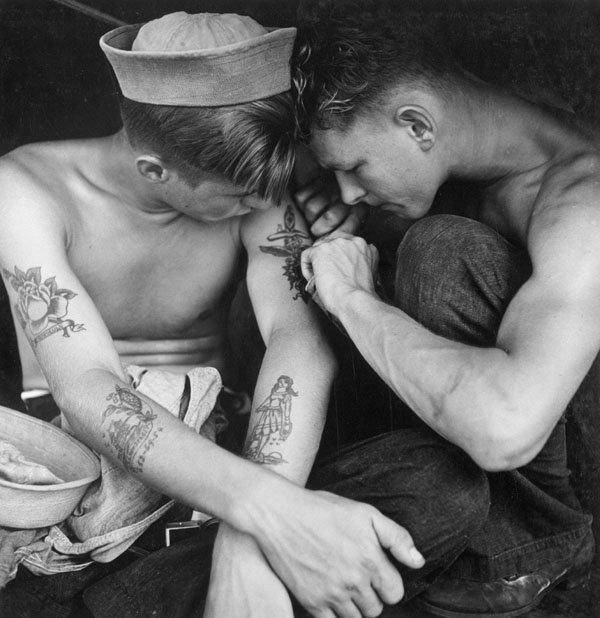

This tattoo means the sailor is loyal and willing to fight anything, even something as sweet and beautiful as a rose.
Dragon.
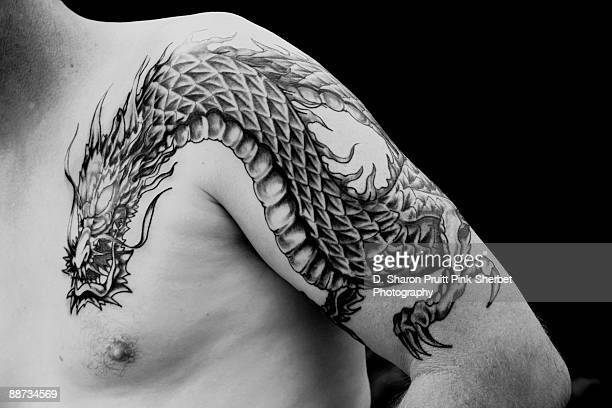

Wearing a dragon means that the sailor served in China.
Golden dragon.
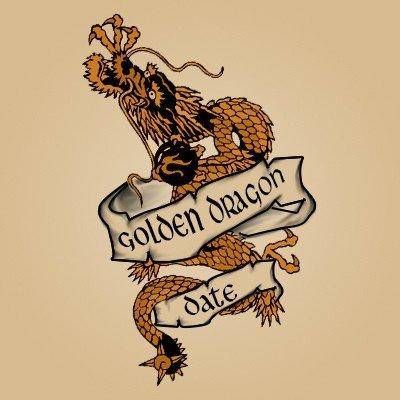

When a sailor crosses the International Date Line, he is entitled to wear a tattoo of a golden dragon.
(The International Date Line is an imaginary line of longitude separating two calendar dates. When someone sails from east to west, they set their clocks back an hour for every 15 degrees of longitude they pass. When they cross the date line, they get a full 24 hours).
Harpoon.
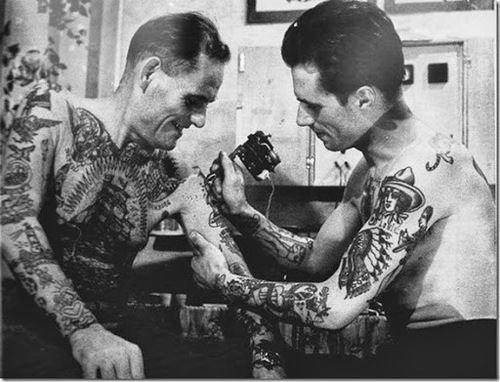

Sailors with harpoon tattoos served in the whaling or fishing fleet.
Neptune.
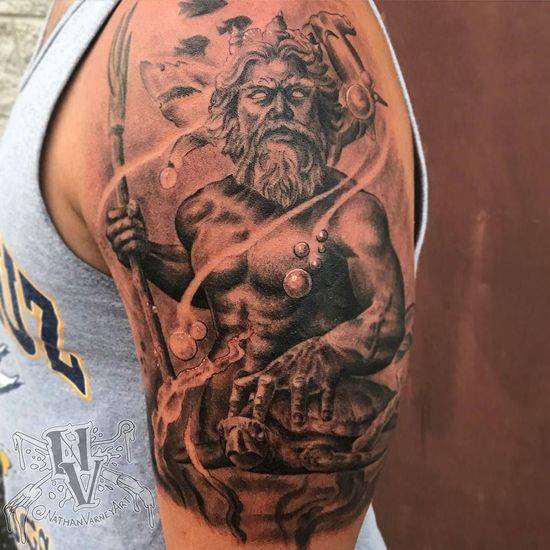

Another badge of honor for crossing the equator.
Palm.
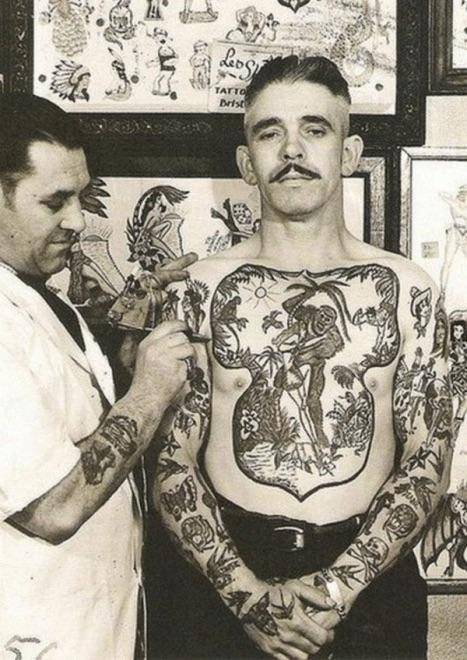

Ship propellers.
- A more extreme form of sailor body art: one large propeller ("twin propellers") is tattooed on each buttock to keep the bearer afloat and push him (or her) back to home and loved ones.
There are guidelines for placing the above images on various parts of the body.
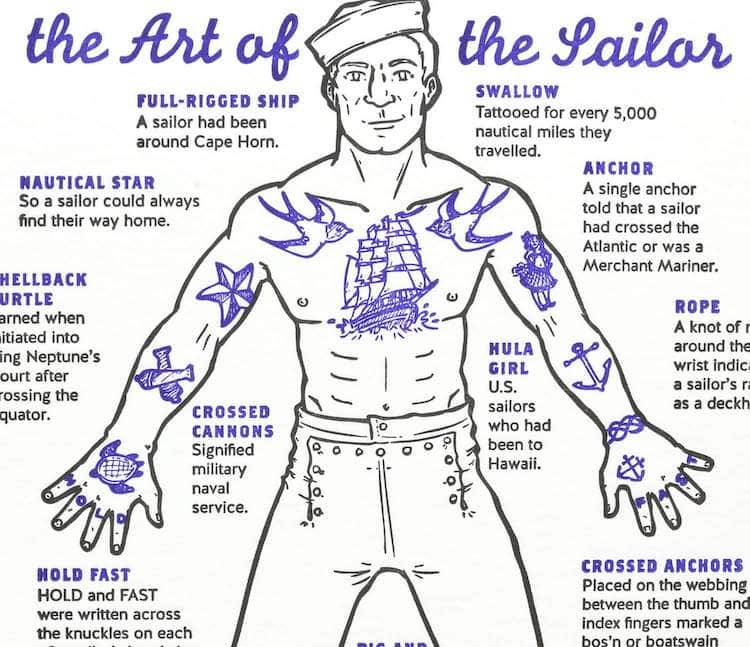

But with the introduction of the new rules, this is not dogma, but simply a recommendation based on historical tradition.
Composition of subjects.
The high art of naval tattooing.
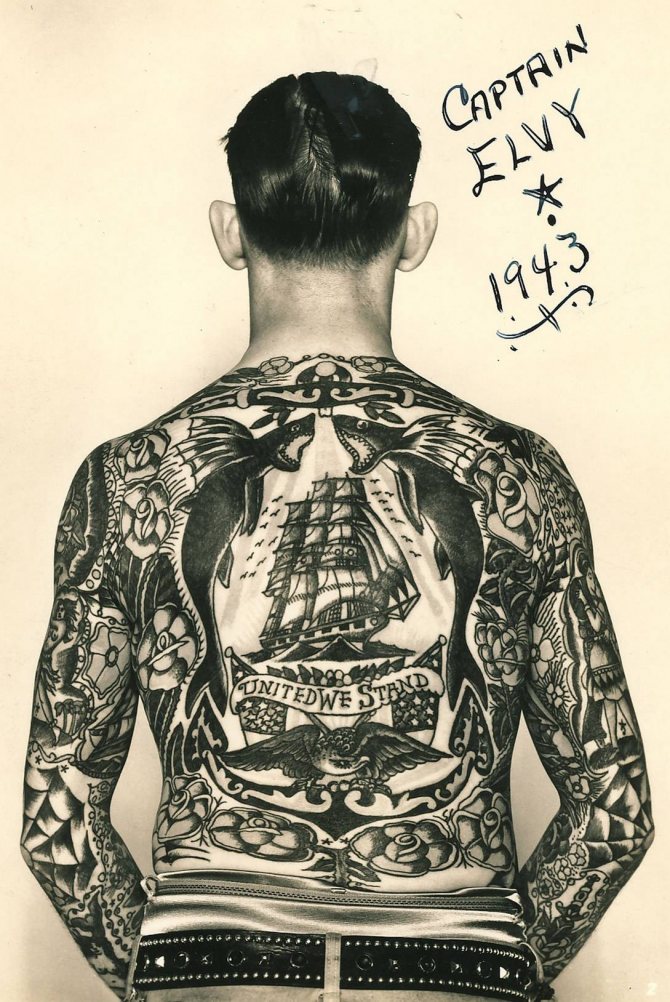

Captain Alvey, who worked in the circus, shows off his beautiful back designed by "Sailor" George Fosdick.
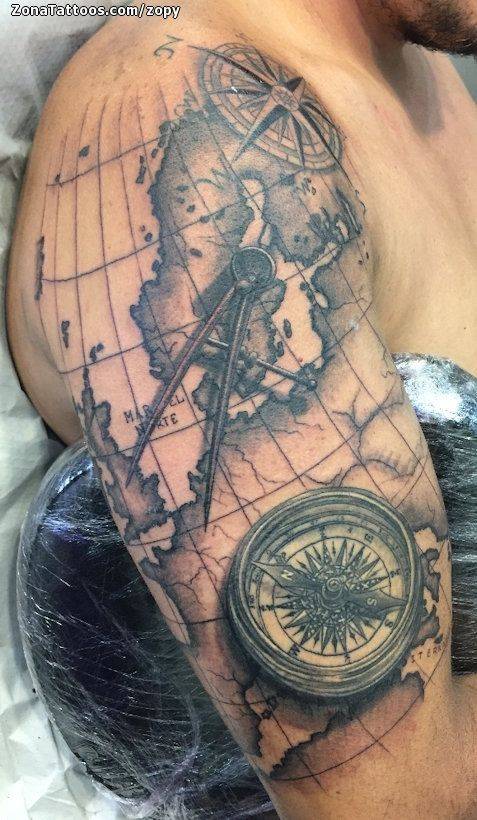

Marines.
According to a spokesman for Marine Commandant Gen. Robert Neller, the updated tattoo policy does not apply to Marines
, even those serving in the Navy's chain of command.
The Marines are simplifying their tattoo policy, but not allowing arm tattoos that would be visible on short-sleeved uniforms, such as physical training uniforms.
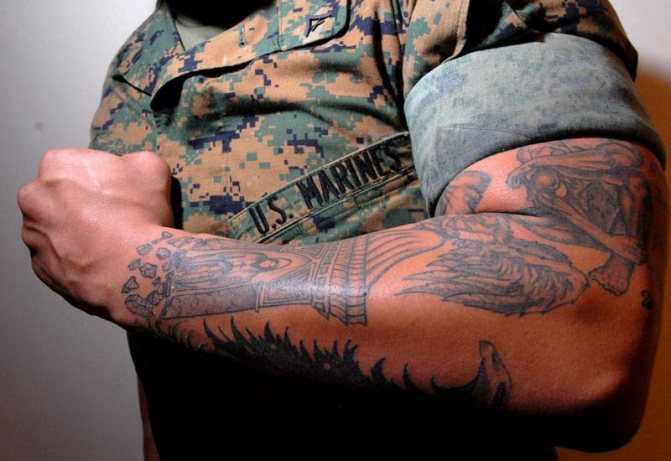

But the U.S. Marine Corps has stricter controls than the Navy.
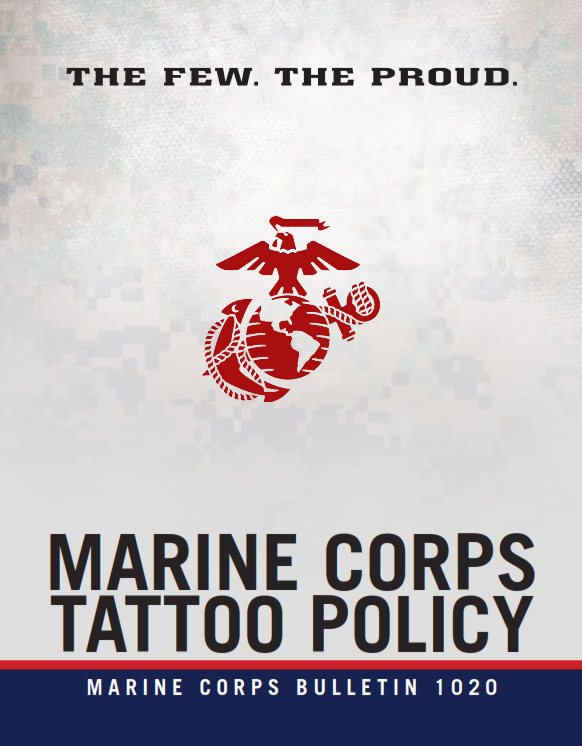

The 30-page manual details what is and isn't allowed.


As well as methods and sophisticated means of controlling the conformity of the subject and the dimensions of the image on the surface of the body.
Rules for women in the Navy.
Slightly different from men's, but the plots are more romantic...
The expression of deep philosophical thoughts.
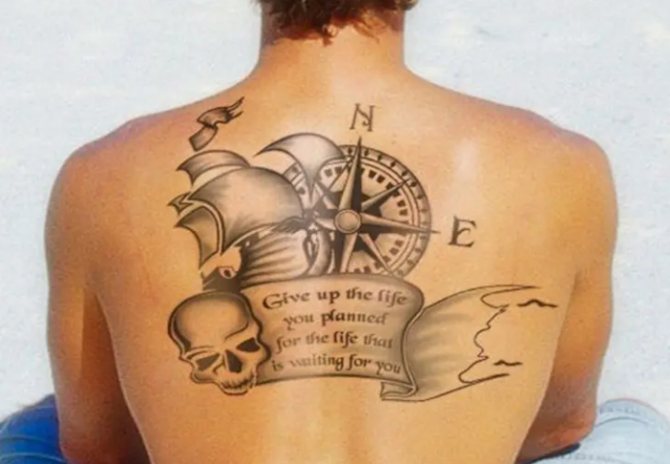

This tattoo design is a great way to convey that you are part of the Navy. The compass is bordered with the ship's flag, skull and inspirational quotes. The compass indicates the direction of the ship, and the skull symbolism depicts the danger associated with their lives.
What happens if you are caught with an illegal tattoo after you enlist in the Navy?
Sailors who are found to have a tattoo with prohibited content may be subject to disciplinary action.
Disciplinary action may include involuntary discharge in the most extreme situations. The U.S. Navy gives commanders the discretion to decide what tattoos are acceptable under its tattoo policy. Unless it is an extreme case, most sailors are given the option of having their tattoos removed or altered in accordance with current rules and regulations.
Navy manning and combat readiness
The base of the current enlisted population in the U.S. Navy is young men between the ages of 18-25. They are the ones who predominantly use body art to express themselves. It is estimated that at least 40 percent of them have at least one tattoo.
The Navy is facing a shrinking pool of draft-eligible people, and doesn't want to limit that pool even at the expense of the tattooed.
A Navy spokesman says there really was no choice.
"When you start putting additional restrictive factors on these people that really have nothing to do with their ability to do their job or get security clearance, it really doesn't make much sense," he said. "We just decided that it was in the best interest of our Navy and the nation to review the policy and make it more reflective of societal realities."
NAVY
Typically, Navy tattoos are applied to the shoulder or hand. The images include:
- The St. Andrew's flag or the naval flag of the Soviet Union, depending on the period of service.
- Abbreviations indicating the specific fleet: Baltic, Black Sea, Northern Fleet. Sailors and officers of the Northern Fleet complement the inscription with the image of a polar bear.
- Shark, anchor, wind rose, compass, gulls, sailboat and other maritime paraphernalia. Many of them have a protective function or symbolize fearlessness.
Also the composition of the Navy tattoo can be complemented by a specific ship, a cruiser, on which the years of his youth were spent.
Photos of Navy tattoos
Popular techniques of execution.
The classic variant of the maritime tattoo is a style of old-school, because the progenitors of this technique were exactly the sailors. The main elements of this direction just are anchors, mermaids and ships. A more large-scale and colorful execution of the sea tattoo is obtained in the style of realism. Due to the colors and talent of the master on the body it is possible to create unique subject lines, revealing all features of the internal state of the owner of the tattoo. The main feature of sea tattoos is their symbolism, so if you want to decorate your body with a seascape, be sure to learn the meaning of all the details. Because someday you might get a "connoisseur" of nautical tattoos and you will have to justify your bodily decorations.
Marines.
The most common variant of the Marine Corps tattoo is the anchor, carried over from the insignia. It is complemented by the blood group, unit number and other important data. Identify the infantryman is also able to skull in a black beret. Most of the tattoos of the Marines are plot related to animals, which symbolize the power, activity, the ability to adapt to difficult conditions and survive under any circumstances. The popular ones are:
- panther;
- wolf:
- tiger;
- bear;
- shark.
The images are made against the background of an unfolded parachute. Death without anguish, good health, longevity on the tattoos of the Russian Marines is often represented by a bat. Sketches with dolphins are also in demand. This is a symbol of ingenuity, new life, the ability to feel great in the water element.
Photo tattoo of the Marines
For women
Tattoos with numerous small attributes are the prerogative of beautiful ladies. The most common female version of the sketch is considered a drawing of a ship with sails of scarlet color, which speaks of a gentle, sensitive and romantic nature of the tattoo hostess. The image of a ship with an anchor on a woman's body speaks of selflessness and devotion to her family. Anchor is also a symbol of stability. It is not uncommon for young ladies to apply such tattoos as a sign of respect for their husbands - sailors. Drawings of this nature mean patience and loyalty. A graceful schooner with patterns or flowing lines indicates the dreaminess of a beautiful lady. She is often not serious and often has her head in the clouds. The star above the deck in women's tattoos is a symbol of faith in the future and an irresistible desire to achieve the goal.
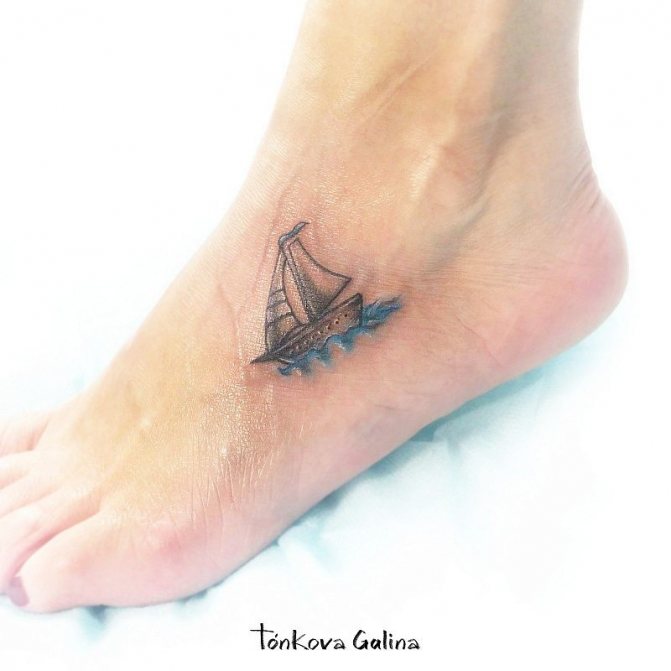

Military Intelligence
As in other cases, the military intelligence tattoo is applied after the end of service, when the need to hide their belonging to a secret group of troops disappears. Here, the most common option is considered a bat, which is applied to the back or chest, that is, areas hidden under clothing. This mammal represents noiselessness, the ability to remain active in the dark, elusiveness, and agility. Its wings can be spread or folded. The stylistics used in military intelligence tattoos are rarely diverse. Images can be both flat and volumetric, they are performed in the technique of newscool, dotwork, blackwork, realism.
Photos of military intelligence tattoos
For men
Representatives of the stronger sex refer to such tattoos as a talisman. The image can talk about the belonging of its owner in the past or present to the navy or demonstrates his readiness to protect his homeland and loved ones, especially if the tattoo depicts a warship. A drawing of a sea vessel fighting the elements during a storm symbolizes fearlessness. The owner of such a sketch is not afraid of life's trials and confidently pursues his goal. If the man's body depicts a ship sailing away with white sails, it means that in front of you is a creative person, always ready for adventure. The pirate flag as an additional detail of the sketch symbolizes the unwillingness of its owner to obey the laws and rules.
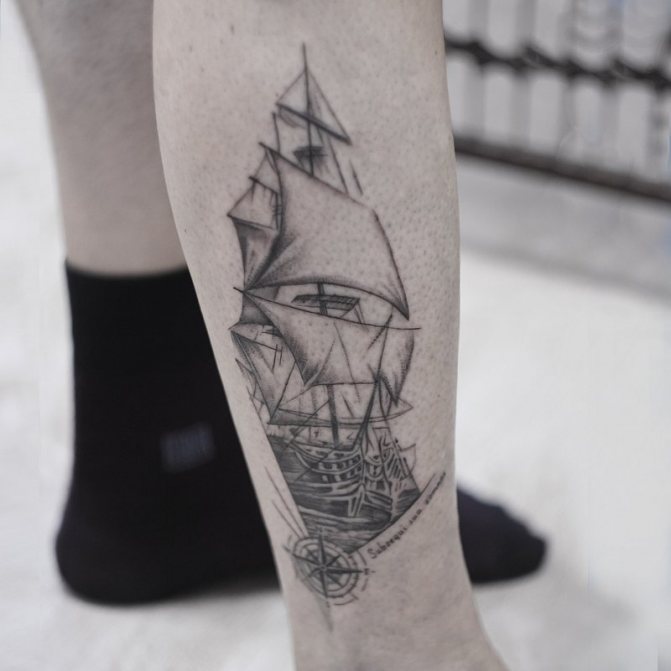

GRU Special Forces
The military, belonging to a special intelligence unit in the Ministry of Defense, likes to indicate the dates of service, place, squad number. As in many other secret forces, GRU special forces tattoo choose the image of a bat, but it is applied on the forearm. The drawing is complemented by an open parachute, a target. These GRU special forces tattoos can use a wide variety of stylistics, often referring to the popular comic books about Batman - the kind, quick, discreet helper of all those who have been wronged.
Also popular among the military in this category are:
- Skull wearing a beret in front of a parachute. The skull, known in iconography as Adam's head, is a symbol of death and glory, rebirth, fearlessness, and willingness to sacrifice himself for his countrymen.
- Roaring Tiger. A symbol of readiness to fight back the enemy, tremendous strength and wisdom at the same time.
- Flying Helicopter. Drawing with commandos landing on the forearm and scapula. It is often a composition with a complete story. He chooses those who have undergone baptism of fire in hot spots.
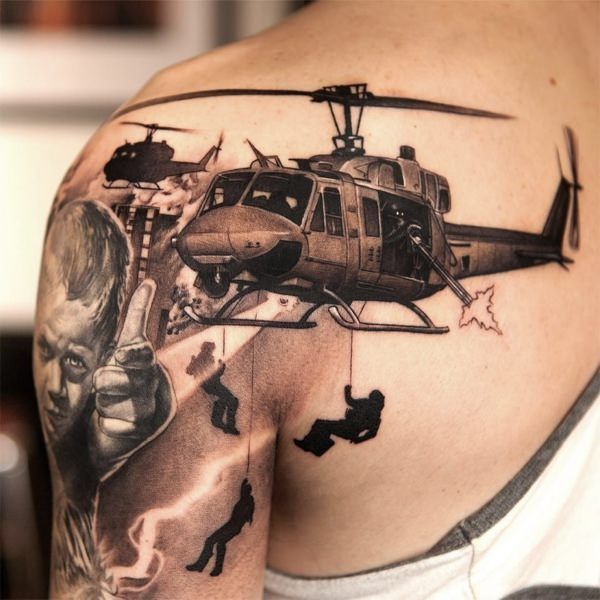

GRU special forces tattoos photo
Types of sketches
Wear jewelry with the image of a naval vessel has many variations of execution. If you look at the expanses of the Internet or look at photos of finished work in any tattoo parlor, you will definitely be convinced of this. In addition to well-known sketches from art books and models of ships from movies, your eyes will be opened numerous drawings of an individual character. This fact means that you can both choose to apply the tattoo ready-made sketch, and draw it yourself.
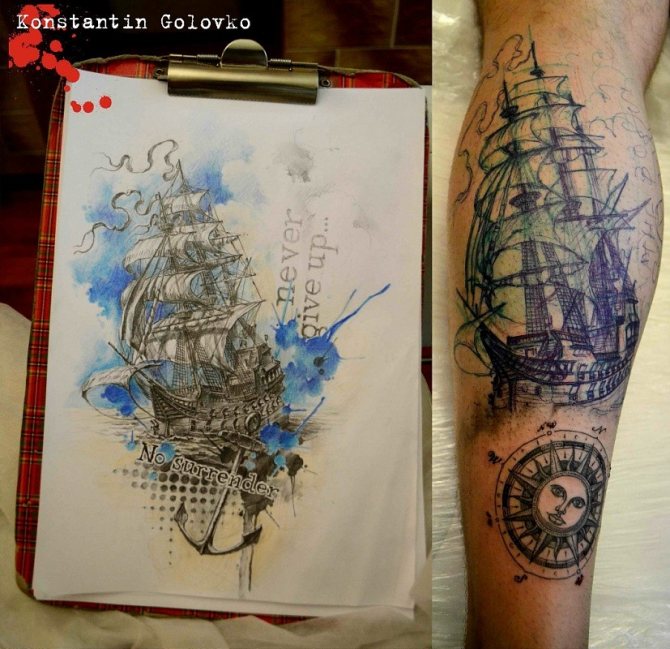

Among the popular offerings is the ghost ship "Flying Dutchman" with specific sails in the form of a ragged web, the famous pirate ship "Black Pearl", numerous drawings in the style of minimalism, sunken ships on the background of reefs and underwater residents, ship during the storm, at sunset and many other ideas. Sketches can be small and monochrome, or on the contrary, can be colorful and show the presence of many details. Women's types of tattoos are often complemented by beautiful love inscriptions, flowers and floral motifs. In men's tattoos there are lighthouses, compasses, maps, spyglass and many other attributes of sailors and travelers.
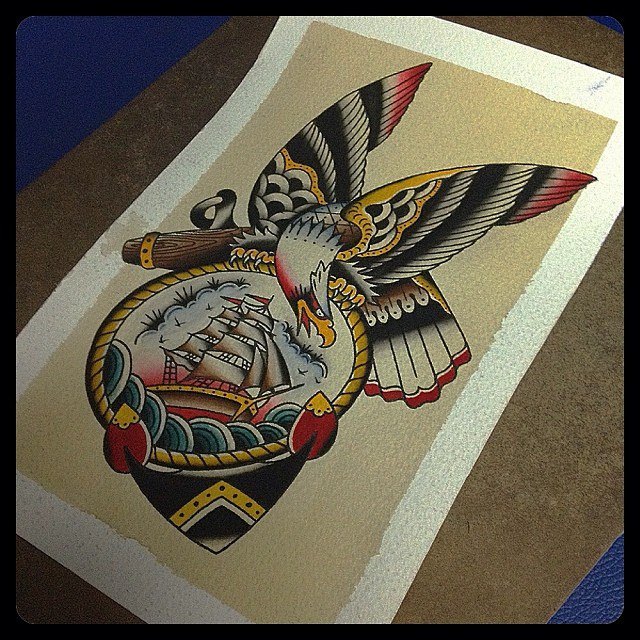

AIRBORNE
Paratroopers are known to all Russians because of their brightness and boisterousness. Their main insignia are the vest, the blue beret and the VDV tattoo. In carrying out their duties, they had to land in the most dangerous areas and immediately engage in battle, so this group of troops took the strongest, most fearless, invulnerable guys. In memory of the combat past after service, almost all of them do VDV tattoo on the shoulder or completely nail the sleeve. Nakolki are narrowly specific and include an image:
- parachute;
- aircraft;
- number of the military unit;
- blood type and rhesus factor.
In addition, VDV tattoos on the shoulder are complemented by highly specialized inscriptions, the most popular options: "No one but us" and "For the Airborne Troops." As a rule, people who do not belong to the army's elite community do not order such body art. Ex-military men come to the tattoo artists who want to tweak the outline of pictures that have blurred over time or refine the composition. Other versions of the Airborne tattoo may include a skull in a beret against a background of fire, a tiger, a wolf, other strong and always ready to attack animals.
Army tattoos - photo
AIRBORNE FORCES
The closed category includes tattoos of the Strategic Missile Forces - missile troops of special purpose. As in the case of the intelligence, the most widespread in this narrow milieu was the analog of the patch, which captures the rocket launcher taking off. Not only the nuclear reactor gives it strength, but also the symbolic wings. Often the image is complemented by the phrase: "Only silence after us. It can be complemented by a two-headed eagle with arrows, a howling wolf, a bear holding a weapon. They demonstrate great strength and responsibility for the preservation of peace in the world. The technique of execution is chosen by an ex-military man himself. If twenty years ago it was an uncomplicated flat pictures, notable for a high level of performance, today such military tattoos can become a real masterpiece.
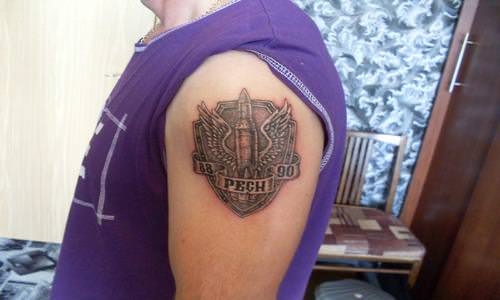

Photos of the Strategic Missile Forces tattoos
